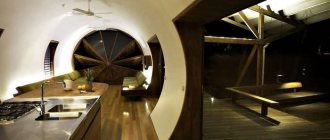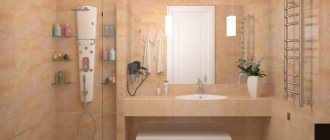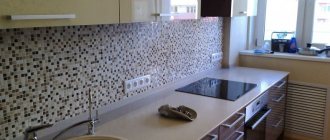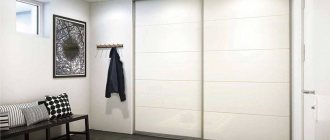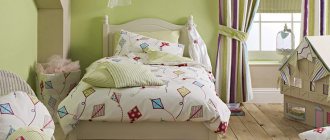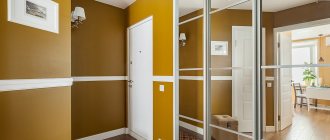In this article we will look at how to hide computer wires under the table in an unusual, stylish, practical and interesting way.
Home computer equipment is connected to the network using a considerable number of different wires. Due to the lack of many stationary sockets, you have to supplement this rather large set with extension cords and adapters. All these wires often interfere with work, getting underfoot. As a result, the risk of breaking any of them increases several times. In addition, such a “web” does not look very aesthetically pleasing. It will be better for everyone if the wires are carefully hidden, and we will tell you in detail how to do this in this material.
Why hide computer wires: basic safety rules
The wires and cables that are used to connect computers are not simple. They serve not only to transmit electrical energy, but also to send data and signals. If you look at a computer cable from the inside, you can see that it consists of one or more colored pairs of wires that are intertwined with each other. This is not without reason, because such a scheme improves reception and, of course, signal transmission.
The following types of computer wires are known:
- wires that do not have a common shield are called UTP;
- wires with a screen made of aluminum foil - FTP;
- wires, the common screen of which is made of copper mesh, but a separate pair has its own additional screen, are called STP;
- wires whose overall shield consists of a foil mesh, and each individual pair has its own additional shield, are called SSTP or S/FTP;
- then the wires that do not have a common screen, but each individual pair has a foil screen, are called U/STP;
- and the list is completed by an improved model of wires that consists of two screens. One is made of foil, and the second is made of copper mesh. They are called SF/UTP or simply SFTP.
Important: Although it is worth noting that all categories of computer wires stand out among other relatives by their higher resistance to changes in temperature, current and various loads, including voltage failures. But make sure you have a proper outlet and carry, preferably one with a fuse.
Simple rules for storing computer wires
Do not forget that a computer cannot work without wires. The laptop will, of course, last for a while, but without a charging cord it won’t last long. You need to treat cables with care and know the basic rules for storing them.
- You need to put special silicone pads on the coils of wires. There are colors for every taste, so it will be easy for you to choose one that matches your interior or just the one you like.
- Do not twist the wires at random, they may break and deteriorate. The same applies to the traditional winding of wires into a skein.
- Keep unnecessary wires out of sight. Put away any unnecessary cables that you are not currently using. Chargers, extension cords and adapters must have their own place for storage!
- Do not forget about the simple rules for operating wires and cables, regardless of their type and even the outer sheath. Unplug them from the outlet and replace cables that have damaged insulation inside or outside. Otherwise, you and your family risk getting an electric shock if you come into contact with such a wire.
- If the wire is exposed, the risk of water getting inside increases. The result is a short circuit and fires in the house. Do not allow liquid to come into contact with the wires. By the way, you should not place water near computer equipment. It is better to drink tea, coffee and other drinks in the kitchen.
- Pet rodents can get electrocuted and die. Why, overly inquisitive children can get hurt!
- A large accumulation of wires can not only cause injuries and falls, but even more serious consequences.
- Do not overload the carriers and take into account their possible transfer! This will protect the devices themselves, in particular the computer, from breakdowns.
- Do not forget to periodically clean sockets, carriers and wires with the equipment itself from dust . In general, dust is the worst enemy of all electrical partings. And together with foreign objects, for example, threads, feathers or other household debris, they can cause a fire in the house.
This is a nice way to hide the wires
What can be used from special fittings
In fact, the problem of extension cords and cables collecting dust under office desks and cabinets is not new. To hide the wires from the computer and all the office equipment connected to it, there is no need to reinvent the wheel. It is enough to study the range of furniture accessories of any large specialized store. And you can choose several options. With the help of special devices, entire “highways” are created that are accessible for maintenance and do not interfere with everyday life.
For example, the MDM kit contains such fastenings for wires.
And baskets for power blocks (sources), blocks of mortise sockets and plugs of various sizes for decorating countertops.
There are many manufacturers and the range is really wide, for different price categories.
How to stylishly hide wires from your computer: life hacks and devices for convenient storage
The same problem often occurs in the home and office. There is a lot of equipment, and even more wires and cables. In order to organize them and not get confused about which cord comes from which equipment, we suggest using some clever devices.
- The easiest way to use tags . Colored labels that identify each cable and tell you what it is used for. You can make such a simple device yourself. For this purpose, colored Velcro or price tags are suitable, on which you can write the necessary information.
- Clips can “take on” the important mission of storing wires . They also have Velcro, which is very convenient. You just need to choose a suitable place, attach the clip and insert the cable. By the way, they come in a monochromatic and even slightly strict design. But you can, for example, glue green leaves on them. If you need a budget option, then such leaves can be cut from ordinary plastic colored cups.
- You can make them yourself or, alternatively, use rolls on which toilet paper is wound. Just keep in mind that the cardboard itself must be thick enough to withstand the pressure of compressed wires.
Ordinary stationery clips will help you create a very stylish picture.
- Plastic fasteners have long demonstrated their practicality. In our case they will also come in handy. They will collect several wires in one place, and they will not get tangled. Fasteners come in different colors and sizes.
- "Sombrero with under-table mounting." No, we are not talking about a hat that is placed on the head. And for a small device that will collect three wires in one place and hide them under the table. This way, the cables will disappear from view and will not clutter up the space.
- “Absorber balls” will help you store cables This device looks like a colored tennis ball. But it can accommodate up to five meters of cable.
- Small springs in all the colors of the rainbow will easily group your wires in one place. You can wrap wires with such springs simply to decorate the cables. This device looks interesting and new. By the way, for small wires and as a cheap option, a tube cut in a spiral is suitable. However, she won’t wrap the wires so tightly. But it will help to separate them by consumption groups or simply divide them by value.
You can easily make such a simple rug yourself
⇡#Conclusions
To be honest, while writing the article, I couldn’t help but feel that Captain Obviousness was closely watching me - the things that were discussed in this article were too obvious. However, as practice shows, for many users some of the described techniques turn out to be a discovery, and I am sure that this material will be useful - a topic that clearly shows what the user’s system unit can look like externally and how to achieve this should be on our website. Among our (by no means all) readers there is an opinion that all these glasses, lights and other modding decorations are not needed. I hold a different opinion and, taking advantage of my official position, I declare this openly. The main thing is that in the pursuit of beauty, other components of the computer do not suffer: performance, reliability and functionality.
We would like to express our gratitude to representatives of ASUS and Corsair for the equipment provided for testing.
What is a practical way to hide computer wires under your desk?
Everything should be in order, but the tangled mass of wires under the table gets in the way and is wildly annoying. There are several practical ways to remove it all and restore order and harmony in your home.
- Wires that are located closer to the floor can be easily hidden using an electrical baseboard . There is space inside it and you can freely insert several thin or one thick cable.
- specially made box . You can take any box, make the necessary holes in it and place a whole carrier with wires. You can also look for such a gadget in stores. By the way, this device will protect from dust getting into the joints.
Such a box can easily be made even from an unnecessary shoe box.
- If renovations are in full swing in an apartment or house, then do not miss the opportunity to immediately disguise the wires . Cables can be hidden by making a groove for them in the wall, or veiled under wallpaper. You can put a thin plastic cover on top so that the wires are always accessible. Just choose the right groove size.
- If you don’t like to bother, then just hide the wires at your discretion right under the table cover . Use regular screws, clips, or at worst double-sided tape. This trick will not bring aesthetics to your home, but it will remove the “bundle” of wires from under the table from prying eyes. You can also use a staple gun, just use it carefully. So as not to damage the wires themselves.
- A corrugated or regular hose is also a great option. After all, several wires can be pulled through it at once. They will not get confused, but will be stored in one place. If the simple appearance does not attract you, you can diversify it with homemade decorations. Although it is not always appropriate to clutter it with unnecessary materials near a cluster of wires.
Even an ordinary corrugated hose will be an interesting solution to hide wires
Unusual wiring decoration
The simplest solution is to install cable channels, which today are offered in a wide variety of sizes and shades, but this is too simple. Shouldn't we use decorative clips as fastenings, which will additionally hold and guide the cable? Cute clamps in the shape of leaves and birds are on sale; camouflage covers are also produced in the same theme, which can be decorated with bright stickers or drawings.
You can group the wires on the wall in the form of a decorative tree with lush foliage; here artistic skills or self-adhesive film will come to the rescue. In a few minutes, the cable will turn from a chaotic tangle into a blooming garden.
You can decorate a cable running along the walls with a decorative fence, and in order for it to lie neatly behind it, you must first secure the wires with zip ties or hook holders with an adhesive base. In addition, the fastening can be made from ordinary Velcro, choosing a color that matches the interior.
How interesting is it to hide computer wires as part of your home interior?
Computer wires can serve more than just transmitting energy or data. If you have a little imagination, desire and time, then they can be used as an addition to the design of the room. This option is original and solves several problems at once: where to put the wires and how to decorate the room. Let's consider several options for storing wires and cables from a computer.
- Wall decoration of wires as an art form. Don’t doubt that the wires on the wall will also make a nice pattern, flower or tree. You can create a small collage for pictures or family photos.
- Wire curtains are an easy method for lazy individuals or simply for those who do not have time to decorate a room. The decorative curtain under the table is a curtain for all the wires. Moreover, such a curtain can be purchased or made in a hand-made style, and there are no restrictions in choosing its color or additional decorations. By the way, if you have unnecessary, old or damaged things, then a composition of multi-colored scraps will help create an interesting curtain for wires under the table. Moreover, to create it you don’t even need to have a sewing machine. After all, multi-colored and thick floss threads will only complement the bright picture.
- By the way, even on a computer desk you can adapt wires this way. You just need to do this from the side of the wall. Wires will be contained, will not interfere with cleaning in the area, and will not be visible to your guests.
A simple but practical solution to hide wires under the table
- Add an interesting twist to the interior of your home - decorate wires and sockets . The cables can easily be wrapped with thick rope or colored tape. There are no restrictions on color, it all depends on the style and your imagination.
- A very beautiful solution would be a “necklace” of wires . To make it, you just need to put beads with a large diameter on the wires themselves. True, in order to string them, you will need to either disconnect the cords themselves from the plug, or choose them with a narrow entrance. Although there are even special designs with such beads, so you can order them in a store.
- Wires can make an interesting, creative panel . Using clips, they can be shaped into clocks, castles and entire cities. You can get silhouettes of animals or figures in the style of abstractionism. Or you can simply repeat your computer desk.
- fence for wires would be a good life hack . True, it will only cover those wires that lie on the floor. But it is incredibly easy to create - just attach such a fence to the baseboard using any fastening. And children can put homemade birds or other animals on it. Yes, even just by gluing colorful flowers to it.
- You can hide not only wires, but also sockets. They should not be accessible, especially if there is a small child in the house. You can cover them by buying special limiters in the store, or by getting a little creative and sewing a cover . Add a pocket to this case, and there will be additional storage space, for example, a charger. This pocket will also be convenient for charging your phone near an outlet.
You can easily sew such a cover yourself
- Drawers and chests are suitable for storing chargers, extension cords and headphones. You can make the inside of the cell out of cardboard or wood. Decorate such a chest in an antique style, hang an interesting lock, and another stylish decorative element will appear in your house.
- You can hide unnecessary gadgets, for example a router that takes up a lot of space, in a book . Remove the selected book, which for some reason is just gathering dust, remove the pages and place the router there. Just don't forget to make holes for the horns. It comes out stylish and, most importantly, the table is tidy. You can also cut out similar safes for carrying cases. You just need to cut it strictly according to the shape.
- We would like to share another life hack for decorating rosettes . You will need colored stickers and imagination. Give the rosettes the shape of flowers and add frames. Make the shape of funny animal faces or emoticons. Yes, they will not please the eye for long. But every month you can change something in your decor.
- If you are good at using various available tools, then make decorative doors for accessible sockets . Sockets will be decorated with taste and protected from curious children and dust. In order not to spend too much financially, arm yourself with ordinary plastic bottles. They bend well, are found in every home and can easily be further decorated even with ordinary varnishes or paints.
- Hiding wires behind a picture is easier than even the simplest option. The method is not original, but it is practical and fast.
You can easily make such a box with doors for wires yourself
Laying in the baseboard
An old and proven method. There are a few details to take into account:
- It is much easier to lay the cable when it is without connectors. Arrange to cut them off and then install new ones;
- doorways can be wrapped around the perimeter, placing everything under the trims. In this case, measure the cable oversized or consider extending it;
- Coaxial cable curls a lot when new. Therefore, it is worth straightening it completely before laying it;
- During the installation process, there may be places where it will not be possible to install it in the baseboard. In this case, use a brown cable duct. It can be placed above the baseboard or in other places.
How to hide and decorate wires at a computer desk: design ideas
The problem of tangled wires has been known for a long time. To facilitate the task of smoothly integrating them into the interior of the house, kits and accessories developed by designers from all over the world will help. New items appear often, so you can buy them for yourself or make an original gift. We invite you to take a closer look at some of the proposed inventions.
- The designers have already worked hard and come up with a set of Wire Blooms for decorating wires and cables in the house. In the set you will find a red bird made of plastic and green leaves made of the same material. In a few minutes your wires will turn into a blooming garden with singing birds. Lots of wires - there will be a whole green forest. By the way, you can group many of the ideas proposed above into one composition. For example, lay out a tree on the wall with wires, and use these clips to secure and decorate the same cords at the same time. We also mentioned above that even using scrap materials you can repeat a design solution. True, it will be very difficult to cut out such a beautiful bird.
- The idea is similar to the previous version. But it looks much brighter and more modern. The only thing missing is a bird. But you can “seat” colorful animals on such branches at your own discretion, or even make them yourself with your children.
- But that's not all. Creative developers have thought through everything to the smallest detail. By looking at the “face” of the hook, you will immediately understand which device the wire comes from. And this will not only help remove the coil of cords from under your feet, but also sort them according to the necessary criteria.
Such simple colored fasteners have long won many fans.
- No matter how hard you try, you won’t be able to hide all the wires, much less extension cords. Designers offer an original solution to this problem - a WirePod extender. Looks like a pattern in an abstract style. It complements the design no worse than other decorative elements, and you definitely won’t want to hide it.
- “Wire and Cable Trap” is a ring with notches of different sizes and diameters. Suitable for different types of wires. Easily mounted on a desktop. The table material can be different - both wood and plastic. The device will collect chargers and computer cables in one place. But be prepared to drill a hole in the table.
- Donut- shaped extension cord This spherical device will allow you to wrap the wire along its axis, and a special recess is designed for this. This way you can adjust the cable length yourself. And the gadget looks interesting and fits easily into the interior.
- A new product from a Korean designer deserves attention - Takayaki . Essentially, this is an extension cord, but, like any Asian product, it acts as a high-tech gadget. Functionality is not compromised, and its appearance looks very impressive. The rosettes are shaped like balls, painted with Chinese patterns. But that is not all. Such balls are illuminated at night with multi-colored lights and look unusual in the dark. If you look into it in detail, the gadget will surprise even a seasoned connoisseur. These balls can move apart into two hemispheres. This is done so that you can wind a long wire and avoid cable tangles.
- And if you completely remove the top part, you get an additional charger for numerous devices that allow wireless charging. The extension cord can serve as a stylish night light, as an additional and pleasant bonus.
Computers, televisions, tablets, phones and other modern technology have long been part of our lives. This entire “arsenal” is connected using wires. If you show your imagination and spend a little time, these cables will become not only a functional device, but also a complete addition to the interior. Just buy or make the necessary devices. But if you think globally, it is better to immediately hide the wires in the wall or under the baseboard during repairs.
⇡#About cable management
Before you buy all the hardware needed to assemble a system unit, you need to make sure that all components are compatible with each other. It’s not for nothing that the case specifications indicate the maximum height of the installed processor cooler, as well as the length of the power supply and video card. It’s not for nothing that the characteristics of the cases indicate how many and what kind of radiators can be mounted on its walls. You won't have any problems here.
|
|
|
In the article we are talking about assemblies in tower cases, but there are some peculiarities here too. Today there are three types of towers: Full-Tower (supports motherboards of E-ATX and XL-ATX form factors), Mid-Tower (supports motherboards of ATX format and smaller) and Mini-Tower (designed for devices of mini form factor -ITX). Naturally, the larger the motherboard, the larger the case needed.
When selecting a power supply, it is important not only to focus on its length. Here it is important to buy such a device so that its cables are long enough, because in 2022, in most cases, the power supply is installed from the bottom, and the 8-pin EPS connector is usually soldered to the upper left part of the motherboard PCB. It turns out to be a fairly simple rule: the EPS cord should be equal in length to the height of the case, if we are talking about the lower location of the power supply. Then there will be no surprises during assembly. In general, the length of other power supply cables in the case of tower cases is of little interest to us. In some models, the length of the cord with a 24-pin port reaches 700 mm - in this case, it is even more problematic to properly lay it behind the chassis of the case.
For greater clarity, I will provide the following table.
| Types of buildings | ||||
| Full-Tower | Mid-Tower | Mini Tower | Slim Desktop | |
| Approximate height | 550+ mm | Up to 500 mm | Up to 400 mm | Up to 400 mm |
| Supported motherboard form factor | E-ATX, ATX, mATX, mini-ITX | E-ATX, ATX, mATX, mini-ITX | mATX, mini-ITX | mATX, mini-ITX |
| Number of expansion slots | 1-7 | 1-7 | 1-4 | 1-4 |
| Power supply form factor | ATX | ATX | ATX, SFX | ATX, SFX |
| Recommended cable length 4+4 EPS 12V for CPU power supply | From 550 mm | Up to 550 mm | Up to 500 mm | Up to 400 mm |
As a rule, the higher the power of the power supply, the more wires it has. Because the same 850-watt power supply is quite suitable for systems with two video cards. Typically, expensive models with a power of 650 W or more come with two EPS cords. We have already found out that in the case of home overclocking - when using an air cooling system, non-separable or custom "water supply" - you can safely limit yourself to one 8-pin EPS power supply cable.
Installation of the junction box
There are some nuances here too. It’s worth starting with the fact that in rooms with concrete walls it is recommended to use diamond-coated drill bits, since the more common models with pobedit coating wear out quickly, and you will have to buy additional drills. They can only be used in houses with walls made of finblocks. Typically, when working with finblocks, it is prohibited to use diamond-coated crowns for the same reasons.
Before milling begins, a hole with a diameter equal to the drill is made in the center of the installation, which will make the work much less difficult. Experts recommend choosing boxes with a diameter of 6-7 cm; this will be quite enough for 6 cores. If you plan to connect several sockets in a row, the place for them is leveled.
Hide wires using various tricks
However, you won't be able to completely get rid of wires. After all, there are still extension cords, chargers, power cables, HDMI cables, speaker cables, not to mention the workplace with the computer and all its peripherals. Listed below are a variety of ways to solve this problem in your home and office.
Attach them to furniture
The problem of dangling wires can be solved ingeniously and inexpensively by laying them along the table legs.
Hide them in drawers
The extension cords, along with all the plugs, fit perfectly into the drawers. Looks much better than on the floor.
Photo sources: www.apartmenttherapy.com / www.houzz.com
Hide them behind the curtain
The space under the table is perfectly masked with such a curtain.
Photo source: randomenthusiasm.com
Make a charging station
Place the surge protector in a nice box. The output holes can be labeled to distinguish which charger is whose. In Chinese online stores you can find many ready-made charging stations for every taste.
Photo source: my.rehabhelp.biz
Cable organizer
Use ready-made solutions or make an organizer yourself from office clips.
Photo source: rsmagazine.ru
Use them as a photo hanger
You can benefit from a cable running along the wall by hanging photos or postcards on it.
Take up cable art
Well, if no option suits you, go from the other side. Cables will hide themselves if you make them into a work of art!
Photo sources: www.designlovefest.com / i.pinimg.com
External camouflage
If they have an artistic taste, many people prefer to decorate rather than hide the wires. From standard wiring it is quite possible to make a real art object, painting, panel with your own hands. Typically, cables come in black or white, but if desired, you can find a material of a brighter shade.
Next, you should choose a drawing that suits the style of the interior, sketch it with a non-greasy pencil directly on the wall. Afterwards, you need to measure the length of the circuit using a thread in order to purchase the missing amount of cable (part of it will only serve a decorative role).
You can make any wall pattern out of wires. Often the following are taken as a basis:
- branch with leaves, sitting birds;
- one or more trees;
- giant light bulb;
- power station;
- highway (in the nursery);
- decorative fence.
The wires are attached to the wall with special fasteners, which can then be decorated with any suitable material - fabric, special paper, designer decorations. Also, unsightly protruding wires are hidden behind tall indoor plants, well-placed furniture, carpeting, door frames, and windows.
Photo life hack 7. Box for sockets
Cover-boxes of this type for volumetric sockets and pilots are sold in construction supermarkets and interior design stores (for example, in Ikea).
The device can not only cover an unsightly outlet with a splitter and a dozen plugs, but also several meters of cable neatly rolled under it and pressed tightly against the wall.
It’s easy to make a “cap” with your own hands from:
- an even piece of opaque barrel;
- caskets or boxes;
- cardboard;
- opaque food-grade plastic container;
- and so on.
Operating procedure
At the first stage, brackets are installed on the wall to fix the TV. The corners of its location should be marked with electrical tape; during work, this will allow you not to go beyond the zone that will be hidden. Now the technician will have to mark where the socket for connecting the device will be located. On the surface of the drywall you can mark for future holes. The installation area of the socket must be marked to the nearest millimeter, this will allow it to be installed without creating voids.
To lay cables in the wall, cable channels should be made. Another hole is made in the lower part of the wall, through which the wire will be hidden in the plinth with the cable channel. The socket can be installed behind the TV, but this is only relevant when it is removed from the surface or installed on a movable bracket. In this case, the outlet will be easily accessible.
Photo life hack 2. Clip-on clothespins
Attach a regular household clothespin to the inside or outside of the table with double-sided tape. Or buy a ready-made Velcro clip at an office supply store.
This is a reliable mount for a wire that keeps falling from the table to the floor (for example, a phone charging cable or a microphone plug).
Before attaching the clip to the table, wipe the area with a cotton pad soaked in alcohol or acetone to degrease the surface and the clip will hold more securely.
Barsky recommends
To make your work as enjoyable as possible, approach the design of your workspace as professionally as possible. The furniture manufacturer and official distributor No. 1 in Ukraine - Barsky invites its customers to evaluate high-tech innovations in the world of office and home furniture solutions.
Adjustable tables with a solid drawer are the optimal solution for the office and home.
And so that shopping brings only joy, we offer convenient purchase options with boring for businesses and individuals. Also for our customers - free delivery and guaranteed quality of all products. For more detailed information, see the company contact department and product catalog.
Decor with stickers, stickers, improvised means
Decorative elements that help hide or neatly secure numerous cords are sold almost everywhere and are quite inexpensive. In this way you can decorate the cord coming from the sconce above the bed in the bedroom. You can decorate the cable from the TV or the cord from the heater running along the floor using a “toy” mini-fence glued to the baseboard. If you plan to carefully hide many elements behind a fence, tie clamps are used.
Decorative clamps are now sold in all electrical stores. They are an adjustable flexible clip decorated with leaves, flowers, butterflies, birds, and houses. In romantic interiors, laces are decorated with sparkles and feathers, in a children's room - with stickers depicting fairy tale characters and favorite cartoons.
Photo life hack 4. Stationery clips
The largest size penny paper clips are placed on the edge of the table and a wire is threaded through their metal head. Now the necessary wire will not fall off the table and will always be at hand.
To use it, just unhook the clamp from the table without removing it from the cable, and after use, hook it back to the table. Or simply pull the cable out through the clamp by the end.
It is important that the thickness of the table should be the width of the clamp, otherwise the latter will fly off at the slightest touch.
1. Hide the extension cord with chargers in a box
The extension cord with chargers constantly gets in the way on the table or under your feet, collects a lot of dust, and also looks unaesthetic. Dealing with this problem is very simple: take a nice box, make a few holes in it and hide all the wires and cables there.
homedit.com
homedit.com
homedit.com
There are also ready-made solutions, for example Plug Hub from Quirky. This is a box made of hard plastic with a rubberized bottom. There are three holes on top for cables, and inside there are three fasteners that can be used to wrap cords that are too long. The Plug Hub can be placed on the floor or mounted on the wall.
amazon.com
Wi-Fi Almighty, or how to cover all devices with the Internet
Of course, you already have a Wi-Fi router. But whether you use it to its full potential is a question.
Use a Wi-Fi adapter
How many times have I seen this picture: I have a laptop, but the Internet works via cable. The reasons are different: some cannot find the drivers, others have a problem with the hardware. But everything can be resolved. Drivers can be selected by any computer technician with straight hands, and a burnt-out Wi-Fi module can be replaced with an external USB adapter.
A regular system unit can also be connected via Wi-Fi. To do this, you will need the same USB adapter or PCI card with external antennas.
Cover all corners
The signal from the router may go out due to improper location, microwave ovens, reinforced concrete structures and other obstacles. Therefore, please take into account the following:
- place the router in the center of the apartment (office);
- place the router at a distance of at least 1 m from the floor;
- do not place near a microwave oven;
- If your gadgets support Wi-Fi 11ac standard, use a dual-band router. It will help avoid interference when working in overloaded airwaves. This is true for apartment buildings, where almost every family has Wi-Fi.
- if the router's power is not enough, use Wi-Fi repeaters to distribute the signal evenly throughout the room.
To ensure that even inexperienced users can purchase the right equipment, the Wi-Fi Alliance has decided to simplify the names of current and future standards. Now the main Wi-Fi standards will be publicly referred to by numbers instead of letters: • 11n → Wi-Fi 4 • 11ac → Wi-Fi 5 • 11ax → Wi-Fi 6
Camouflage covers
You can make your own cover for one or several cords at the same time from plastic bags cut into long, narrow strips. A kind of “sleeve” is knitted or crocheted from them, into which all the necessary wiring is inserted. To hide an extension cord with charges in this way, a handbag of suitable size is knitted or sewn.
Some stores offer decorative collapsible plastic covers in the form of tree branches, colored tubes, and shiny snakes. This design does not have the protective properties of cable ducts, but it is acceptable to cover “ugly” wires with it. If desired, a special spiral braid can be purchased - it is flexible, has an aesthetic appearance, and allows you to hide both one element and many wires.
Useful tips
In order not to get confused when masking the wires and not to get into trouble during repairs, they must be marked in advance. This will help you immediately find the right cable later. It is better to separate low-power wiring from power wiring, without connecting it into a single bundle. Wires from the antenna and the Internet should be placed separately from others so as not to spoil the signal quality.
Cables should have the shortest possible length and the minimum number of connections: this increases their safety and reduces the risk of injury. It happens that the braid of hidden cables frays due to poor placement, so in dangerous places the wiring must be checked more often. If you need to mask wiring, you can use any ideas, especially since the range of tools and materials for decoration is now huge!
